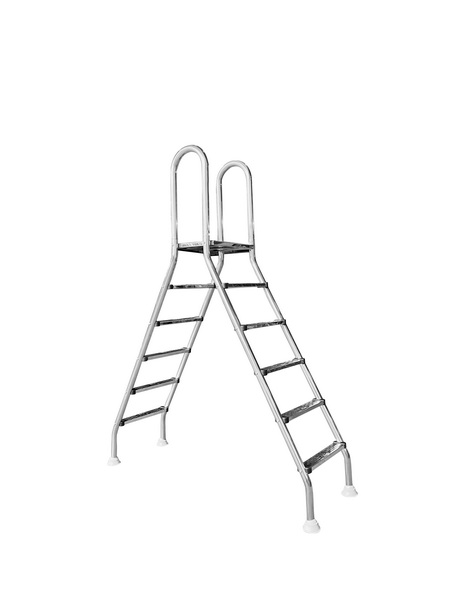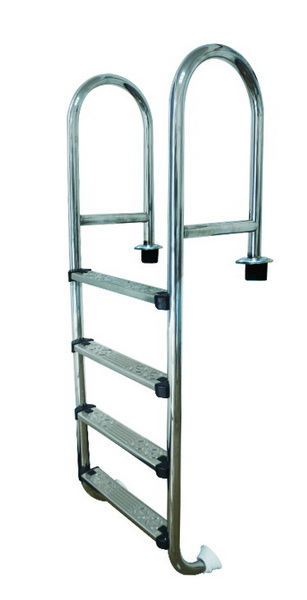Views: 222 Author: Tina Publish Time: 2025-10-21 Origin: Site








Content Menu
● Why Build Your Own Above Ground Pool Ladder?
● Detailed Step-by-Step Instructions
>> Step 1: Measure Your Pool Height and Width
>> Step 2: Choose Your Ladder Material
>> Step 4: Cut the Ladder Steps
>> Step 7: Attach Steps to Side Rails
>> Step 8: Install Ladder Feet Caps
>> Step 9: Apply Non-Slip Treads
>> Step 10: Test for Stability
● Additional Customizations and Enhancements
>> Handrails and Safety Features
>> Integrating with Pool Equipment
>> 1. What materials are best for an above ground pool ladder?
>> 2. How many steps should my ladder have?
>> 3. Can I add non-slip surfaces to my ladder?
>> 4. How often should I maintain the ladder?
>> 5. Will my ladder fit pools with sand, DE, or cartridge filters?
Building an above ground pool ladder is a practical project that can enhance the safety and convenience of accessing your pool. Whether your pool uses sand filters, DE filters, or cartridge filters as part of your filtration system, a sturdy ladder is essential for easy entry and exit. This comprehensive guide will walk you through step-by-step instructions to build a robust, durable ladder tailored to your pool setup.

Purchasing a pre-made ladder can be expensive and sometimes may not perfectly fit your pool's specifics. Building your own ladder gives you the flexibility to customize height, width, and materials to suit your pool and personal taste. Moreover, it can be a rewarding DIY project that saves money while helping you understand your pool better.
DIY ladders also allow integration with your existing pool equipment, such as water pumps, LED lights, and filtration units, ensuring your ladder placement does not interfere with these essential elements.
- Pressure-treated lumber or aluminum (both resist water damage)
- Stainless steel screws or bolts to avoid rust
- Waterproof wood glue (for wooden ladders)
- Sandpaper (medium and fine grit)
- Power drill and drill bits
- Saw (hand saw or power saw)
- Measuring tape and carpenter's square
- Level to ensure even steps
- Pool ladder feet caps or rubber pads to protect liner
- Non-slip tape, rubber grip strips, or ladder tread covers for safety
- Protective gloves and safety glasses
> Tip: Using aluminum makes a lighter ladder that resists corrosion, especially in pools with LED lighting systems.
Before starting construction, consider your pool's shape, wall type, and exact height. The most common pool heights are 48 to 54 inches, but specialized pools may vary. Your ladder should comfortably extend 6 to 12 inches above the pool deck to give secure handrails.
Design a ladder that provides safe climbing and accommodates the pool's surroundings, such as the position of pumps and filtration systems. Avoid blocking access to sand filters or impeding LED light fixtures.
Measure from the ground to the pool's top rail or deck. Also, measure the width between where ladder rails would rest securely. Confirm these measurements twice for accuracy.
Decide between pressure-treated wood or aluminum based on durability and aesthetics. Wood is easy to work with and customizable; aluminum offers excellent weather resistance and lightness.
Cut two side rails from your chosen material. The length should be the pool height plus about 8-12 inches for handgrip extension.
Decide on the number of steps needed—usually 3 to 5. Cut the treads to a comfortable width (usually 15-20 inches) ensuring enough surface for standing.
Sand all wood edges thoroughly to eliminate splinters and rough surfaces. For metal, use a deburring tool or file to smooth cut edges.
Mark and drill pilot holes for attaching the steps to prevent splitting wood or damaging metal.
Position the steps evenly spaced, approximately every 10-12 inches along the side rails. Use stainless steel screws or bolts with waterproof wood glue (if wood) to secure steps firmly. Check each step with a level before tightening screws.
Attach protective caps or rubber pads to the bottom ends of the ladder rails. This protects your pool liner from punctures and increases friction to reduce slipping.
For safety, add non-slip tape or ladder tread covers on the top surface of every step. These provide traction when the ladder is wet.
Place the ladder next to the pool and test it for stability and comfortable hand placement. Ensure there is no wobbling, and the ladder rests securely on the ground.

Consider adding handrails to the top section of your ladder for extra support when entering or exiting the pool. You can attach these from the extended side rails or add separate rail pieces using sturdy brackets.
If your pool height changes seasonally or you have a cover, a ladder design with adjustable or detachable steps can improve usability and storage.
Apply exterior-grade sealants or paint for wooden ladders to extend durability against sun, rain, and pool chemicals. For aluminum ladders, check regularly for dents or corrosion.
Position your ladder to avoid interfering with your pool's water pump, filter system, or LED lighting fixtures. A properly placed ladder keeps your pool setup neat and accessible.
- Perform weekly inspections for loose screws or cracks.
- Clean non-slip steps regularly to remove algae or dirt.
- Tighten screws and replace worn parts promptly.
- Reapply sealant on wooden ladders annually.
- Store ladders indoors or cover during off-season to prevent weather damage.
Building an above ground pool ladder is a manageable and rewarding DIY project that enhances pool safety and accessibility. By carefully selecting materials, following precise measurements, and applying safety features such as non-slip treads and secure handrails, you can create a customized ladder perfectly suited to your pool's dimensions and equipment. Regular maintenance will keep your ladder sturdy and functional for many swimming seasons, making your swimming experience safer and more enjoyable.

Pressure-treated wood and aluminum are both excellent. Wood offers customization and style, while aluminum is lighter and resists corrosion.
Three to five steps are usually ideal depending on your pool's height, ensuring safe and comfortable access.
Yes, applying non-slip tape, grip strips, or tread covers is highly recommended to prevent accidents on wet surfaces.
Inspect your ladder weekly during use season and reseal or repaint wooden ladders annually to protect against damage.
Yes, careful measurement and placement ensure your ladder fits without interfering with any pool filtration or pump systems.
This guide explains how to safely increase pressure on a pool pump by restoring healthy water flow. Learn to diagnose low pressure, clean baskets and filters, fix air leaks, adjust valves and pump speed, and know when equipment upgrades or gauge replacement are necessary.<br />
This in‑depth guide explains how much it costs to replace a pool pump, covering typical price ranges, pump types, labor charges, and long‑term energy savings. Learn when to repair vs replace, DIY vs professional options, and how OEM pump and filter solutions can reduce lifetime ownership cost.<br />
Learn exactly how long to run a pool pump daily for crystal‑clear, safe water and lower energy bills. This in‑depth guide explains turnover, seasonal adjustments, single‑ vs variable‑speed schedules, energy‑saving tips, and practical examples, plus answers to common runtime questions.
This in‑depth guide explains the real reasons your swimming pool pump is not working, from power and priming issues to clogged impellers, dirty filters, and motor failures. Learn step‑by‑step troubleshooting, key maintenance tips, and when to repair or replace your pool pump.
Learn how to remove a pool pump motor safely and efficiently with this step‑by‑step guide. Discover the tools you need, how to disconnect power and plumbing, when to call a pro, and how OEM filter and pump solutions can support overseas pool brands and wholesalers.<br />
This article introduces leading Pool Cleaning Equipment Manufacturers and Suppliers in the UK, outlines their key products, and explains how international brands can combine UK distributors with Chinese OEM factories to build competitive, high‑quality private‑label pool cleaning and filtration lines.
This article outlines the leading Pool Cleaning Equipment Manufacturers and Suppliers in America, explains key product categories such as sand filters, pumps, and robotic cleaners, and shows how importers can combine U.S. brands with Chinese OEM partners to build competitive, high‑margin pool equipment portfolios.<br />
This article introduces the European market for pool equipment and accessories, profiles key Pool Cleaning Equipment Manufacturers and Suppliers, and explores OEM opportunities for Chinese factories producing sand filters, pumps, cleaners and LEDs for European brands and wholesalers.<br />
This article profiles top Pool Filter Valve Manufacturers and Suppliers in Canada, including Praher Plastics, global brands like Hayward and Carvin, and leading distributors. It explains key valve types, buying factors, and how foreign OEM factories can partner with Canadian suppliers for complete pool filtration solutions.<br />
Discover top Pool Filter Valve Manufacturers and Suppliers in Korea, from Korea Filter to SEDA, offering innovative multiport valves, OEM services, and eco-friendly designs for global pools. Explore advancements, certifications, and FAQs in this comprehensive guide to superior filtration solutions.
This article introduces leading Pool Filter Valve Manufacturers and Suppliers in Japan and Asia, covering valve types, key Japanese pool brands, OEM opportunities, and application segments. It explains how advanced engineering, strict quality control, and strong visual marketing help exporters win global pool projects.
This article introduces the main types of Pool Filter Valve Manufacturers and Suppliers serving Russia, including local distributors, industrial filter producers, global brands, and Chinese OEM partners. It explains key selection criteria, product ranges, and OEM opportunities for Russian pool projects.<br />
This article introduces the leading Pool Filter Valve Manufacturers and Suppliers in Australia, explains common valve types and technical features, highlights major distributors and OEM opportunities, and offers practical tips for international buyers sourcing compatible filtration valves and systems.
This article introduces Italy’s leading Pool Filter Valve Manufacturers and Suppliers, detailing their technologies, materials, OEM services, and application scenarios. It explains how Italian valves integrate with sand, DE, and cartridge filters and why global brands choose Italian partners for premium pool filtration solutions.<br />
This article introduces the Portuguese market for pool filtration equipment and highlights how local specialists, European brands, and Chinese OEM Pool Filter Valve Manufacturers and Suppliers cooperate to serve residential and commercial pools, offering multiport valves, filters, pumps, and customized OEM solutions.<br />
This guide explains how to backwash a sand pool filter step by step, when to do it based on pressure readings, and how long to run backwash and rinse cycles. It also covers common mistakes, signs that filter sand needs replacement, and key differences among sand, DE, and cartridge filters.
This article explains how often to change or clean pool filters by type, using pressure-gauge thresholds and real-world conditions. It covers cartridge, sand, and DE filter intervals, step-by-step maintenance, lifespan signs, seasonal planning, and how OEM-sized systems can reduce maintenance while keeping water crystal clear.
This in‑depth guide explains how long pool filter cartridges last, what really affects their lifespan, and the key signs it is time to replace them. Learn practical maintenance tips, filter comparisons, and OEM insights for brands, wholesalers, and pool professionals.<br />
This guide explains how to change the sand in a pool filter step by step, from shutdown and disassembly to removing old sand, inspecting laterals, adding new media, and restarting the system. It covers safety gear, sand selection, backwashing, and common FAQs for clear, safe DIY maintenance.
This article explains practical ways to hide pool filters and equipment using landscaping, fences, sheds, benches, faux rocks, and acoustic barriers. It highlights safety clearances, ventilation, and visual media ideas, helping homeowners and buyers integrate filtration systems into attractive backyards.
